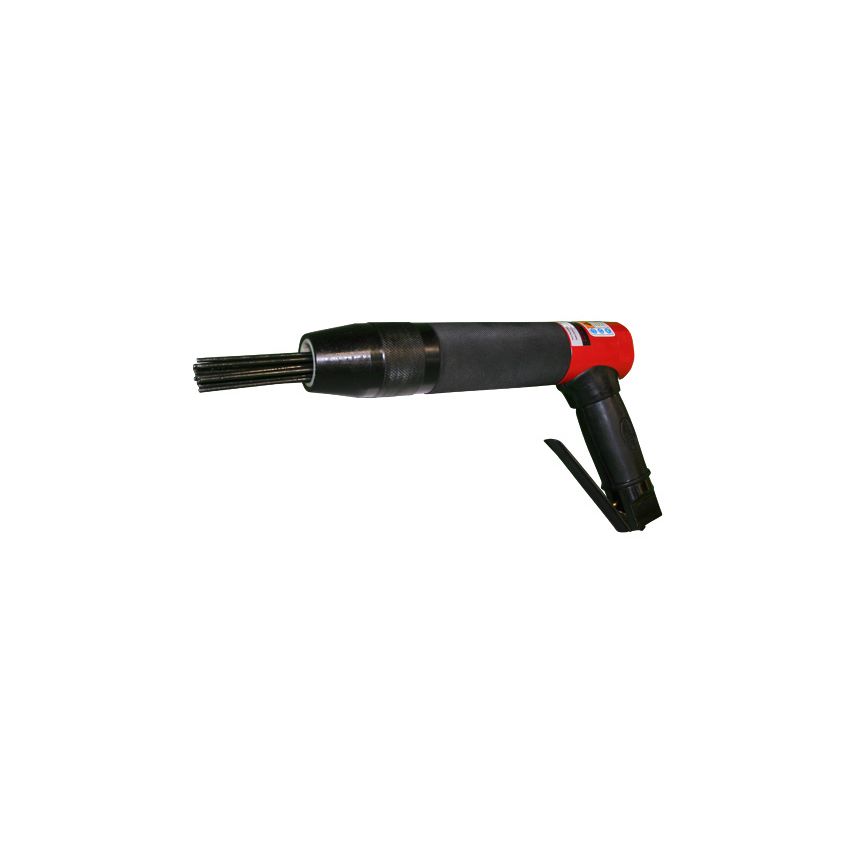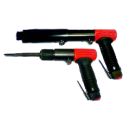Product added to cart
Novatek VRS 3B Pistol Grip Non-Shrouded Needle Scaler
$593.25
In stock
SKU
TT00017-3BPGN
Commonly used as chisel scalers for brick raking, chipping, and splitting applications, VRS needle scalers convert to chisel scalers in seconds!
The 28PG Vibration Reduced Scalers (VRS) have all the impact and functionality of our standard range with dramatically reduced vibration levels. The 28PG VRS scalers are our most powerful pistol grip vibration scalers. These models significantly decreases the possibility of vibration related injuries. All the power with less vibration.
Features & Benefits
- Our most compact, pistol grip vibration reduced scaler.
- Pistol grip configuration is ergonomic and comfortable.
- Steel components offer durability and long-life.
- 3000 blows per minute gives maximum performance.
- Low air consumption allows for use on small, portable compressors.
- Converts to needle or chisel scaler in seconds.
- Dramatic decrease in vibration.
- Operator safety and comfort.
VRS028NPG -Pistol Grip Needle Scalers
- Equipped with 28pcs -3mm x 7″ chisel tip needles.
- 2mm Optional Needle Holders available.
- Tool-less needle replacement for easy field replacement.
- Dust collection shrouds available.
Specifications
- Needle Qty: 28 x 3mm.
- Weight: 7 lbs. (3.5 kg)
- Length: 16.5" (410 mm)
- BPM: 2200
- Air Consumption: 6 cfm (170 lpm)
Part # VRS028NPG -28PG Vibration Reduced Needle Scaler.
| Brand | Novatek |
|---|---|
| Hand Tool Type | Needle Scaler |
| Reach | Short |
| Blows per minute | 3000 |
| Needle Quantity | 28 |
| Air Consumption | 6 cfm |
| Material | Steel |
| Length | 16.5 in |
Placing Tool in Service
- Always install, operate, inspect and maintain this product in accordance with all applicable standards and regulations (local, state, country, federal, etc.).
- Compressed air models always use clean, dry air at 90 psi (6.2bar/620kPa) maximum air pressure at the inlet. Higher pressure may result in hazardous situations including excessive speed, rupture, or incorrect output torque or force.
- Electric models must always utilize proper gauge, and rated electrical cords with correct connections.
- Be sure all hoses and fittings are the correctly sized and secured.
- Ensure an accessible emergency shut off has been installed in the air or electrical supply line. Make others aware of its location.
- Do not use damaged, frayed, or deteriorated air hoses and fittings.
- Always use proper gauge electrical cords with correct connections. (When applicable.)
- Electric models must not use damaged, frayed, or deteriorated electrical cords and connections.
- Keep clear of whipping air hoses. Shut off the compressed air before approaching a whipping hose.
- Always turn off and disconnect the tool from its power supply before installing, removing or adjusting any accessory, or before performing
any maintenance on the tool. - Do not lubricate tools with flammable or volatile liquids such as kerosene, diesel or jet fuel. Use only recommended lubricants.
- Keep work area clean, uncluttered, ventilated and illuminated.
- Keep all electrical connections clear of water or other liquids. (When applicable.)
- Do not operate the machine while flammable or volatile liquids such as gasoline, diesel or jet fuel are present. Failure to do so can result in
explosion. (When applicable.) - Do not remove any labels. Replace any damaged label.
Using The Tool
- Always wear protection when operating or performing maintenance on this tool.
- Always wear hearing protection when operating this tool.
- Always use Personal Protective Equipment appropriate to the tool used and material worked. This may include dust mask or other breathing apparatus, safety glasses, ear plugs, gloves, apron, safety shoes, hard hat and other equipment,
- Prevent exposure and breathing of harmful dust
and particles created by power tool use: - Some dust created by power sanding, sawing, and grinding, drilling, and other construction activities contains chemicals known to cause cancer, birth defects or other reproductive harm. Some examples of these chemicals are:
- - Lead from lead based paints, Crystalline silica from bricks and cement and other masonry products, and Arsenic and chromium from chemically treated lumber. Your risk from these exposures varies, depending on how often you do this type of work. To reduce your exposure to these chemicals: work in a well ventilated area, and work with approved safety equipment, such as those dust masks that are specially designed to filter out microscopic particles.
- Keep others a safe distance from your work area, or ensure they use appropriate Personal Protective Equipment.
- This tool is not designed for working in explosive environments, including those caused by fumes and dust, or near flammable materials.
Read all instructions and data in operation and maintenance manual prior to operation of this equipment.
These instructions are for your protection and convenience. Please read them carefully since failure to follow the precautions could result in injury. Whenever using electric powered equipment, basic safety precautions should be followed.
Prior to use
- Put a few drops of oil through the air inlet using light machine oil. (See recommended lubricants.)
- The compressed air should be free from moisture and contamination. The installation of a filter/regulator/lubricator air preparation set (with moisture trap) is strong recommended.
- Ensure that only 10mm (3/8”) bore airline is used and that all Couplings are tight and in good condition.
- Limit the length of airline to 50ft. Where extra length is necessary, for each additional 100ft, the pressed drop is approximately 0.19ar at 6.9bar.
- Check that the tool is mechanically sound and all airlines are leak free and in good condition.
In use
- Maintain contact with the work surface with sufficient pressure only to keep the tool from bouncing off. Excessive operator pressure will not improve tool efficiency. Handled in this way, the tool will cover a greater area more effectively leaving a more regular finish on the surface.
- In particularly cold temperatures it is recommended that propriety anti-freeze lubricating oil is to be used.
- Ensure that only 10mm (3/8”) bore airline is used and that all Couplings are tight and in good condition.
- Avoid letting the operating pressure fall below 5.5bar (80psi) or rise about 6.9bar (100psi). NOTE: The correct operating pressure is 6.19ar (90psi).
Changing Needles
- Before changing or replacing needles, disconnect the air supply to the tool.
- Unscrew the Front Tube Assembly and remove the Front Assembly. Make sure to keep the Tube Assembly tilted down to not have internal components fall out. NOTE: Take note of how all parts within the front tube fit together as incorrect assembly will result in damaging the
tool when used. - Remove the Needle Holder from the Front Tube and change the Needles. Ensure that all Needles are replaced with new ones.
- Place the Needle Holder back into the Front Tube assembly. Ensure that the Spring is in position and Needles are passing through the center. Refit the Front Tube assembly onto the body and tighten.
Lubrication
- Oil the tool daily during use, applying a few drops of light machine oil through the air inlet. Do not allow oil to enter and perish the air hose. Check the table below for recommended lubricants. Always use clean air tool oil from a sealed container if possible. The use of a filter lubricator in the airline of the tool is also strongly recommended. This will ensure trouble free running and prolong the life of the tool.
Cleaning
- At 100 hours of operating intervals or earlier if the operating becomes sluggish or tools show sign of sticking, flush through with a suitable solvent. Immediately after flushing, thoroughly oil the tool with one of the recommended lubricants.
Note: Replace the 6mm Ball at this time.
Write Your Own Review




